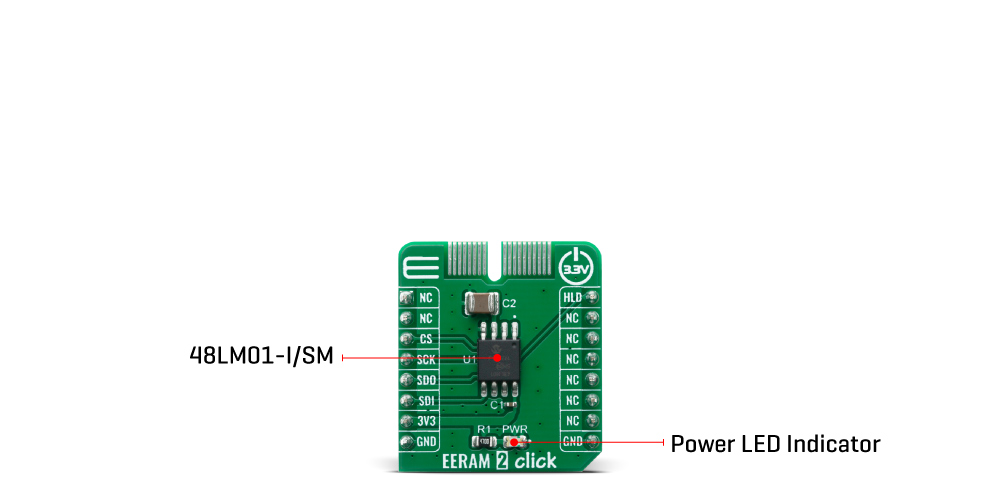35%
OFF
GO LOCAL
| Company | Stock | Price |
|---|---|---|

MIKROE-4129
17 g
Status:
EERAM 2 Click is a standalone serial SRAM memory that includes shadow non-volatile backup. EERAM uses a small external capacitor to provide the energy needed to move the contents of the SRAM to the non-volatile cells when system power is lost. Unlike NVSRAM, no external battery is needed. EERAM offers unlimited SRAM read and write cycles and more than 100,000 backups to the non-volatile cells. Since power loss events are typically random or unpredictable, EERAM works in applications that absolutely cannot lose the quickly changing SRAM data on any sudden power loss. It provides designers of a data logging/black box or monitoring systems with a safe and accurate way to safely, reliably and automatically store the last data bytes prior to the power loss event. The Vcc is monitored inside the IC and can automatically handle the data movement between the SRAM and the non-volatile memory on any power disruption.
The EERAM 2 click is supported by a mikroSDK compliant library, which includes functions that simplify software development. This Click board™ comes as a fully tested product, ready to be used on a system equipped with the mikroBUS™ socket.
This product is no longer in stock
Availability date:
35%
OFF
| Company | Stock | Price |
|---|---|---|

EERAM 2 Click is a static RAM (SRAM) memory click board™ with hidden EEPROM backup. This device can be treated by the user as a full symmetrical read/write SRAM with no limits on cell usage. Backup to EEPROM is handled by the device on any power disrupt, so the user can effectively view this device as an SRAM that never loses its data. The 48LM01 memory IC from Microchip, is structured as a 1024-Kbit SRAM with EEPROM backup in each memory cell. The SRAM is organized as 131,072 x 8 bits with access via the SPI serial interface. The backup EEPROM is invisible and cannot be accessed by the user independently. The 48LM01 includes circuitry that detects VCC dropping below a certain threshold, shuts its connection to the outside environment, and transfers all SRAM data to the EEPROM portion of each cell for safekeeping. When VCC returns, the circuitry automatically returns the data to the SRAM and the user’s interaction with the SRAM can continue with the same data set.

When power is first applied to the click board™, the VCAP capacitor is charged to VCC through the 48LM01 IC. During normal SRAM operation, the capacitor remains charged and the level of system VCC is monitored by the device. If the system VCC drops below a set threshold, the device interprets this as a power-off or brown-out event. The device suspends all I/O operation, shuts off its connection with the VCC pin, and uses the saved energy in the capacitor to power the device through the VCAP pin as it transfers all SRAM data to EEPROM. On the next power-up of VCC, the data is transferred back to SRAM, the capacitor is recharged, and the SRAM operation continues.
Besides standard 4-wire SPI lines, 48LM01 has an additional HOLD pin. This pin can be used for transmission suspend to the 48LM01 while in the middle of a serial sequence without having to retransmit the entire sequence over again. It must be held high any time this function is not being used. Once the device is selected and a serial sequence is underway, the HOLD pin may be pulled low to pause further serial communication without resetting the serial sequence.
The 48LM01 is internally organized as a continuous SRAM array for both reading and writing, along with a non-volatile EEPROM array that is not directly accessible to the user, but which can be refreshed or recalled on power cycles or on software commands. The SRAM array is continuously addressable, so the entire array can be written without having to access pages.
This Click Board™ uses the SPI communication interface and is designed to be operated only with a 3.3V logic level. A proper logic voltage level conversion should be performed before the Click board™ is used with MCUs with different logic levels.
Type
EERAM
Applications
Provides an additional RAM memory for a wide range of embedded applications, especially useful if retaining of the working parameters is required upon the power failure or power off cycle
On-board modules
EERAM 2 Click uses the 48LM01 IC, a high accuracy temperature sensor, from Microchip
Key Features
Unlimited reads/writes on 1 Mbit of SRAM, with the automatic backup and recall to/from the integrated EEPROM, upon power-down. High-speed SPI interface on up to 66 MHz.
Interface
GPIO,SPI
Feature
No ClickID
Compatibility
mikroBUS™
Click board size
S (28.6 x 25.4 mm)
Input Voltage
3.3V
This table shows how the pinout on ERAM 2 Click corresponds to the pinout on the mikroBUS™ socket (the latter shown in the two middle columns).
| Label | Name | Default | Description |
|---|---|---|---|
| LD1 | PWR | - | Power LED Indicator |
We provide a library for the EERAM 2 Click on our LibStock page, as well as a demo application (example), developed using MikroElektronika compilers. The demo can run on all the main MikroElektronika development boards.
Library Description
The library covers all the necessary functions to control EERAM 2 Click board. A library performs the communication with the 48LM01 1-Mbit SPI Serial EERAM on the EERAM 2 click board.
Key functions:
void eeram2_set_write_status ( uint8_t en_write ) - Set write status function.EERAM2_RETVAL_T eeram2_write_continuous ( uint32_t reg, uint8_t *p_tx_data, uint8_t n_bytes ) - Continuous write the data into SRAM function.EERAM2_RETVAL_T eeram2_read_continuous ( uint32_t reg, uint8_t *p_rx_data, uint8_t n_bytes ) - Continuous read the data into SRAM function.Examples description
The application is composed of three sections :
void application_task ( )
{
check_status = eeram2_write_continuous( 0x00543210, &demo_data[ 0 ], 9 );
if ( check_status == EERAM2_ERROR )
{
mikrobus_logWrite( " ERROR Writing ", _LOG_LINE );
mikrobus_logWrite( "--------------------", _LOG_LINE );
for ( ; ; );
}
mikrobus_logWrite( " Writing... ", _LOG_LINE );
mikrobus_logWrite( "--------------------", _LOG_LINE );
Delay_ms( 100 );
check_status = eeram2_read_continuous( 0x00543210, &read_data[ 0 ], 9 );
if ( check_status == EERAM2_ERROR )
{
mikrobus_logWrite( " Reading ERROR ", _LOG_LINE );
mikrobus_logWrite( "--------------------", _LOG_LINE );
for ( ; ; );
}
mikrobus_logWrite( " Read data : ", _LOG_TEXT );
for ( cnt = 0; cnt < 9; cnt++ )
{
mikrobus_logWrite( &read_data[ cnt ], _LOG_BYTE );
}
mikrobus_logWrite( "--------------------", _LOG_LINE );
Delay_ms( 1000 );
}
The full application code, and ready to use projects can be found on our LibStock page.
Other mikroE Libraries used in the example:
Additional notes and informations
Depending on the development board you are using, you may need USB UART click, USB UART 2 click or RS232 click to connect to your PC, for development systems with no UART to USB interface available on the board. The terminal available in all MikroElektronika compilers, or any other terminal application of your choice, can be used to read the message.
This Click board™ is supported with mikroSDK - MikroElektronika Software Development Kit. To ensure proper operation of mikroSDK compliant Click board™ demo applications, mikroSDK should be downloaded from the LibStock and installed for the compiler you are using.
For more information about mikroSDK, visit the official page.
NOTE: Please be advised that any peripheral devices or accessories shown connected to the Click board™ are not included in the package. Check their availability in our shop or in the YMAN section below.